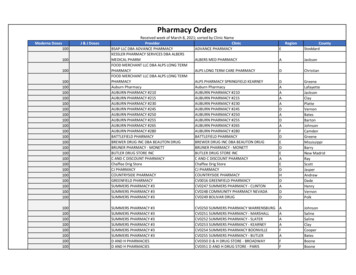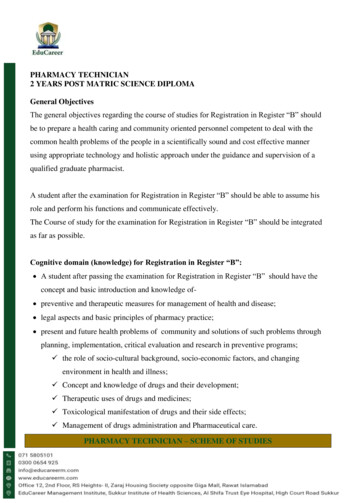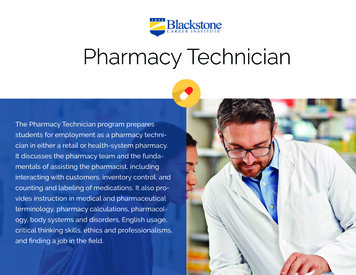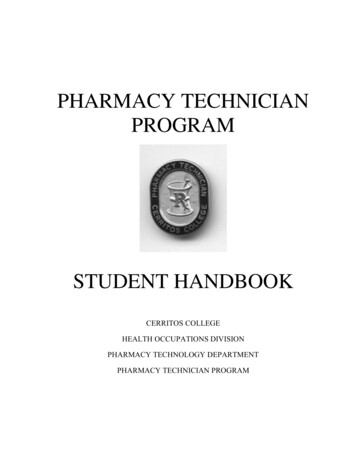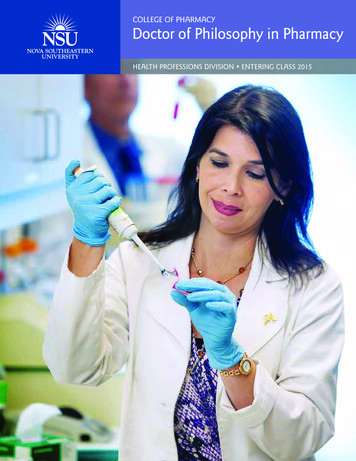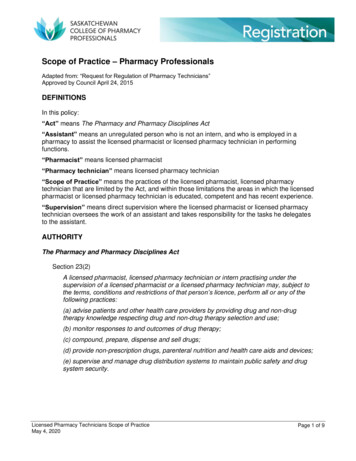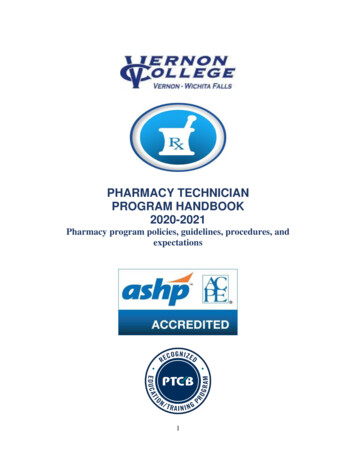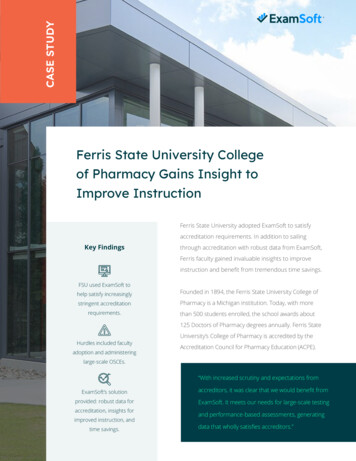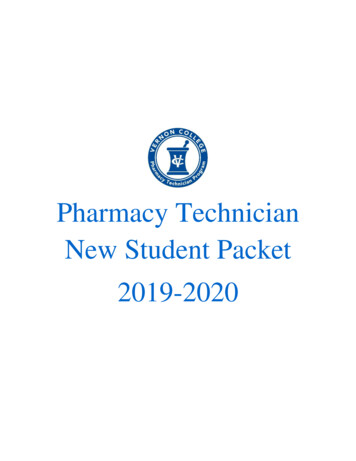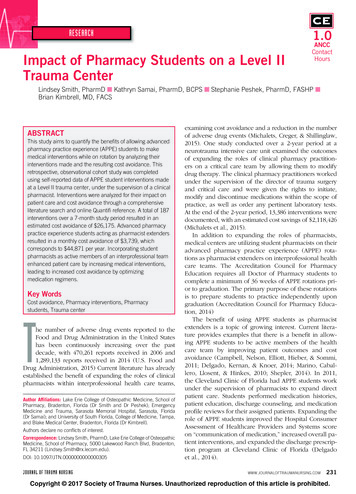
Transcription
RESEARCH1.0Impact of Pharmacy Students on a Level IITrauma CenterANCCContactHoursLindsey Smith, PharmD Kathryn Samai, PharmD, BCPS Stephanie Peshek, PharmD, FASHP Brian Kimbrell, MD, FACSABSTRACTThis study aims to quantify the benefits of allowing advancedpharmacy practice experience (APPE) students to makemedical interventions while on rotation by analyzing theirinterventions made and the resulting cost avoidance. Thisretrospective, observational cohort study was completedusing self-reported data of APPE student interventions madeat a Level II trauma center, under the supervision of a clinicalpharmacist. Interventions were analyzed for their impact onpatient care and cost avoidance through a comprehensiveliterature search and online Quantifi reference. A total of 187interventions over a 7-month study period resulted in anestimated cost avoidance of 26,175. Advanced pharmacypractice experience students acting as pharmacist extendersresulted in a monthly cost avoidance of 3,739, whichcorresponds to 44,871 per year. Incorporating studentpharmacists as active members of an interprofessional teamenhanced patient care by increasing medical interventions,leading to increased cost avoidance by optimizingmedication regimens.Key WordsCost avoidance, Pharmacy interventions, Pharmacystudents, Trauma centerThe number of adverse drug events reported to theFood and Drug Administration in the United Stateshas been continuously increasing over the pastdecade, with 470,261 reports received in 2006 and1,289,133 reports received in 2014 (U.S. Food andDrug Administration, 2015) Current literature has alreadyestablished the benefit of expanding the roles of clinicalpharmacists within interprofessional health care teams,Author Affiliations: Lake Erie College of Osteopathic Medicine, School ofPharmacy, Bradenton, Florida (Dr Smith and Dr Peshek); EmergencyMedicine and Trauma, Sarasota Memorial Hospital, Sarasota, Florida(Dr Samai); and University of South Florida, College of Medicine, Tampa,and Blake Medical Center, Bradenton, Florida (Dr Kimbrell).Authors declare no conflicts of interest.Correspondence: Lindsey Smith, PharmD, Lake Erie College of OsteopathicMedicine, School of Pharmacy, 5000 Lakewood Ranch Blvd, Bradenton,FL 34211 (Lindsey.Smith@rx.lecom.edu).DOI: 10.1097/JTN.0000000000000305JOURNAL OF TRAUMA NURSINGexamining cost avoidance and a reduction in the numberof adverse drug events (Michalets, Creger, & Shillinglaw,2015). One study conducted over a 2-year period at aneurotrauma intensive care unit examined the outcomesof expanding the roles of clinical pharmacy practitioners on a critical care team by allowing them to modifydrug therapy. The clinical pharmacy practitioners workedunder the supervision of the director of trauma surgeryand critical care and were given the rights to initiate,modify and discontinue medications within the scope ofpractice, as well as order any pertinent laboratory tests.At the end of the 2-year period, 13,386 interventions weredocumented, with an estimated cost savings of 2,118,426(Michalets et al., 2015).In addition to expanding the roles of pharmacists,medical centers are utilizing student pharmacists on theiradvanced pharmacy practice experience (APPE) rotations as pharmacist extenders on interprofessional healthcare teams. The Accreditation Council for PharmacyEducation requires all Doctor of Pharmacy students tocomplete a minimum of 36 weeks of APPE rotations prior to graduation. The primary purpose of these rotationsis to prepare students to practice independently upongraduation (Accreditation Council for Pharmacy Education, 2014)The benefit of using APPE students as pharmacistextenders is a topic of growing interest. Current literature provides examples that there is a benefit in allowing APPE students to be active members of the healthcare team by improving patient outcomes and costavoidance (Campbell, Nelson, Elliott, Hieber, & Sommi,2011; Delgado, Kernan, & Knoer, 2014; Marino, Caballero, Llosent, & Hinkes, 2010; Shepler, 2014). In 2011,the Cleveland Clinic of Florida had APPE students workunder the supervision of pharmacists to expand directpatient care. Students performed medication histories,patient education, discharge counseling, and medicationprofile reviews for their assigned patients. Expanding therole of APPE students improved the Hospital ConsumerAssessment of Healthcare Providers and Systems scoreon “communication of medication,” increased overall patient interventions, and expanded the discharge prescription program at Cleveland Clinic of Florida (Delgadoet al., 2014).WWW.JOURNALOFTRAUMANURSING.COM231Copyright 2017 Society of Trauma Nurses. Unauthorized reproduction of this article is prohibited.
Our study aimed to examine direct patient care andcost avoidance to monitor the impact of APPE students ona trauma service. We believe that the interventions madeby APPE students result in improved patient outcomesand cost avoidance.METHODSStudy DesignThis retrospective, observational cohort study was completed using data collected at a Level II trauma center,which is part of a 383-bed medical center. The traumacenter provides services to adult acute care patients whotypically require admission to the intensive care unit orburn unit. The trauma team comprised physicians, medical residents, physician assistants, clinical pharmacists,nurses, and APPE pharmacy students based on their rotation schedule.Student pharmacists on their APPE rotations mademedical interventions under the supervision of a clinical pharmacist. The interventions were analyzed for costavoidance, based on the types of interventions made andthe quantity. During the 4-week APPE rotation blocksstudents participated in interdisciplinary rounds with thetrauma team and were directly involved in managing patient treatment plans. Students reviewed patient profilesdaily and made recommendations that were approved bythe pharmacist and the patient's physician prior to implementation. This study was submitted and deemed exemptby the institutional review board.Data Collection and AnalysisFrom December 2014 to August 2015 students selfreported approved interventions and recorded them ina spreadsheet. All data were void of patient identifiersprior to being received by the researchers. During themonths of March and May students were not scheduledfor rotations, therefore, these months were excluded fromall calculations.To examine the impact the interventions had on directpatient care, researchers analyzed the data with descriptive statistics, focusing on the different types of interventions made in each intervention category. Cost avoidancecalculations were determined with a comprehensive literature search of MEDLINE and PubMed databases, whichproduced a small return of relevant articles. An onlineQuantifi Intervention Cost Savings Justification source andan article published in 2012 examining the cost avoidance associated with pharmacist interventions in a Level Itrauma center were utilized in determining the cost avoidance for each intervention (Hamblin, Rumbaugh, & Miller,2012; Westergard, 2004). The costs of each interventiontype were compared with the two sources and alignedwith the types of interventions made in this study. Costs232WWW.JOURNALOFTRAUMANURSING.COMwere adjusted using the Consumer Price Index Inflationcalculator from the Bureau of Labor Statistics (U.S. Bureauof Labor Statistics, 2015). The cost avoidance calculationsdid not take into account staff salaries as previously published studies have done, since it was not believed thatany of the interventions made by the students would warrant a change in daily staffing requirements.OutcomesOutcome measures were selected on the basis of thetypes of interventions students were making that alignwith what is currently found in the literature. Outcomes ofinterest include the impact on direct patient care throughinterventions made by APPE students (i.e., anticoagulation, antimicrobial stewardship, therapeutic recommendation, hyperglycemia management, discharge counseling,dosage form change, drug information, pain management, renal dosing, medication reconciliation, and other)and cost avoidance to the medical center as a result ofthese interventions.RESULTSDuring the 7 months of data, 13 APPE students made atotal of 187 patient interventions, with an estimated costavoidance of 26,175. The interventions were divided into43% therapeutic recommendation, 15% discharge counseling, 12% drug information questions, 10% antimicrobialstewardship, 9% dosage form change, 4% optimized anticoagulation, 4% medication reconciliation, and 3% renaldose adjustments. However, the impact of addressing druginformation questions could not be determined since thequestions were not always asked about specific patients.The most common type of interventions made weretherapeutic recommendations (n 80), which providedan estimated cost avoidance of 14,093 ( 176/intervention). Within this category, students discontinued unnecessary medications (n 37), optimized pain management therapy (n 17), added medications pertinent totreatment (n 12), provided dosing recommendations(n 3), managed hyperglycemia (n 3) as well as otherchanges to optimize the patient's medication therapy (i.e.,changed the time medications were being administered,replaced two medications with one, and changed onemedication to another). While optimizing the treatmentplans for pain management, students added medication(n 6), discontinued unnecessary medication (n 4),discontinued duplicate therapy (n 2), changed frequency of administration (n 2), as well as reorderedpain medications and provided patient education.Antimicrobial stewardship provided an estimated 4,145 in cost avoidance, with the largest estimated costavoidance per intervention ( 230/intervention), shownin Table 1. This intervention category could be furtherbroken down into discontinuing antibiotics (n 9),Volume 24 Number 4 July-August 2017Copyright 2017 Society of Trauma Nurses. Unauthorized reproduction of this article is prohibited.
TABLE 1Interventions and Associated Cost AvoidanceTotal InterventionsCost Avoidance perInterventionTotal Cost AvoidanceAnticoagulation therapy optimized8 208 1,663Antimicrobial stewardship18 230 4,145Therapeutic recommendation80 176 14,093Discharge counseling29 96 2,784Dosage form change16 64 1,024Drug information22 0 0Renal dosing adjustments6 176 1,057Medication reconciliation8 176 1,409Intervention TypeTotal187changing antibiotics (n 2), dosing recommendations(n 3), initiating treatment (n 2), and switching twoantibiotics to one (n 1).Figure 1 displays the most frequent types of interventions made within the various intervention categories.After analyzing the data collected, the most frequent typeof intervention was discontinuing unnecessary medication.The calculated total cost avoidance for the 7-monthstudy period was determined to be 26,175. Utilizing thetotal cost avoidance, it is estimated that the interventionsmade by the APPE students produced a monthly costavoidance of about 3,739, which corresponds to a totalestimate of 44,871 per year.DISCUSSIONAdvanced pharmacy practice experience rotations are atime for pharmacy students to begin fostering the skillsnecessary for them to become successful pharmacists.Many of the institutional rotation sites offered to students 26,175involve students making independent clinical decisionsbefore having them approved by their preceptor. The students involved in this study were given the opportunity toreview patient profiles daily and identify any drug-relatedproblems. Only the interventions that were not promptedand were approved by the preceptor were included inthe study. The results from this study suggest that theinterventions made by the pharmacy students had a positive impact on the trauma center.The impact interventions had on direct patient carewere interpreted based off of the types of interventionsmade (Figure 1 and Table 1). The most frequent therapeutic recommendation made by the students was todiscontinue unnecessary medications (n 52; 27.81%).Through discontinuing medications that were not needed, students helped minimize exposure to medicationsthat may have risk of adverse effects and/or toxicity tothe patients, as well as avoiding costs by saving resources.Furthermore, students were able to initiate medicationsFigure 1. Types of interventions further broken down. IV intravenous; PO oral; VTE venous thromboembolism.JOURNAL OF TRAUMA NURSINGWWW.JOURNALOFTRAUMANURSING.COM233Copyright 2017 Society of Trauma Nurses. Unauthorized reproduction of this article is prohibited.
(n 21; 11.23%) that patients should have been prescribed to optimize their medication therapy and helpimprove outcomes. Students also recommended dosing(renal adjustments: n 6; 3.21%; and nonrenal adjustments: n 3; 1.0%), changes to warfarin therapy (n 4;2.14%), and changes to antibiotic therapy (n 3; 1.60%).Current literature primarily focuses on the impact thatpharmacist interventions have on cost avoidance, ratherthan student interventions. A study conducted at Vanderbilt University Medical Center's Level I Trauma Centerdetermined the net cost savings of having a clinical pharmacist on his or her interdisciplinary trauma team to be 428,327, during a 1-year study period. This article wasutilized as a comparator to an online Quantifi resource toconduct the data analysis for cost avoidance in our study(Hamblin, Rumbaug, & Miller, 2012; Westergard, 2004).The intervention categories assessed in the Level I traumacenter study aligned with the majority of the interventionswe analyzed. A number of factors contribute to the vastdifference in our estimated avoidance compared with theother study, including but not limited to number of interventions, the individuals making the interventions, size ofthe trauma centers, and number of types of interventionsexamined. When pharmacy students are used as pharmacist extenders as our study has done, it results in additionalcost avoidance compared with clinical pharmacists alone.One study examined the integration of pharmacy students in a Level II trauma center and specifically examinedthe students’ abilities through the use of an ability-basedoutcomes (ABO) assessment, which was completed bytheir preceptor at the end of their 8-week APPE rotation(Petrie, 2011). The ABO assessment measured areas orskills that are beneficial to pharmacists, such as: effective communication, drug therapy assessment, decisionmaking, drug information retrieval, critical thinking, andproblem solving (Petrie, 2011). The areas where studentsneeded improvement included effective communication skills and self-confidence (Petrie, 2011). Advancedpharmacy practice experience rotations provide studentswith an opportunity to develop their self-confidence andcommunication skills, which are displayed differently bystudents who are in the end of their rotation year versusstudents who are just beginning. Rotations that allow students to autonomously act to make patient interventionscan help promote self-confidence in the students.Pharmacy students do not always possess confidencein their skills at the beginning of their clinical rotationyear, which could limit the number and types of recommendations they make. In addition, the students whowere included in our study were only at the site for a4-week period, during which they had to become acclimated to the medical center, the electronic medicalrecords system, and practicing as a trauma pharmacistintern, all of which is new to the students. The first week234WWW.JOURNALOFTRAUMANURSING.COMof the rotation period is typically filled with orientationactivities to help them adjust to the new site; therefore,students were not actively making recommendations every day during their rotation.The capabilities, personality, and level of confidencefor each student appeared to have an impact on thequantity and quality of interventions made each month.Students who possess great self-confidence in their owncapabilities and are more outgoing could be more comfortable making interventions for patients. For example,during 1 month there was only one student on the rotation who made the second highest amount of interventions (n 28) that month alone, compared with everyother month that had two students (average number ofinterventions per student 14.28). External factors mayimpact the interventions students make (i.e., number ofpatients in the trauma center and staffing components);however, it does appear that the way they view themselves plays a role, which could be a topic for furtherresearch.Limitations of this study include the data being selfreported by the students as well as the cost avoidanceestimates calculated from current literature. The natureof it being self-reported leaves room for under reporting. To minimize reporting errors in the data, researchersthoroughly examined each intervention and the notes associated with them to determine whether the interventionwas correctly categorized and relevant to the outcomes.To provide a more accurate estimate of cost avoidancevalues, an electronic reporting system could have beenutilized to record data and calculate the cost of each intervention. Researchers did not own an electronic reportingor cost calculating system, which led to the determinationof costs through online resources.As pharmacist roles within health care teams expand,it is important for pharmacy students to gain early exposure to working closely with interdisciplinary healthcare teams, which will benefit everyone involved. A survey-based study of inpatient internal medicine providersfound pharmacy students to be well prepared and beneficial to the medical team (Lancaster, DiVall, Douglass,& Woolley, 2011). In current literature, there are examples of student pharmacists making a positive impact onpatient care. However, it is believed that this is the firststudy to quantify the cost avoidance with the interventions made within a Level II trauma center.The integration of student pharmacists into the traumateam has increased the number of interventions beingmade, helping optimize patient care. In addition, the student pharmacists are contributing to added cost avoidance due to enhanced patient care. The results of thisstudy are not generalizable to all trauma centers, and notevery trauma center will integrate student pharmacistsin their trauma teams. However, given the progressiveVolume 24 Number 4 July-August 2017Copyright 2017 Society of Trauma Nurses. Unauthorized reproduction of this article is prohibited.
nature of trauma, it is crucial for trauma centers to continuously strive to find new ways to optimize patient care tothe highest standards. Further research in this field couldbe done examining the impact students from other professions have on patient care when given the opportunityto practice as extenders of their supervisors.CONCLUSIONThe integration of student pharmacists into a trauma teamat a Level II trauma center enhanced patient care throughan increased amount of medication-related interventions.Improving patients’ treatment plans ultimately led to anincreased cost avoidance for the medical center throughdiscontinuing unnecessary medications and optimizingmedication regimens.KEY POINTS Pharmacy students on their advanced practice pharmacyexperience (APPE) rotations are able to work as pharmacistextenders. The medical interventions made by APPE students resultedin increased cost avoidance at a Level II trauma center. APPE students can be successfully integrated in interprofessional trauma teams and make contributions to thetreatment of patients.REFERENCESAccreditation Council for Pharmacy Education. (2014). Accreditationstandards and key elements for the professional program inpharmacy leading to the doctor of pharmacy degree. Retrievedfrom the Accreditation Council for Pharmacy Education Web 16DRAFTv60FIRSTRELEASEVERSION.pdfCampbell, A. R., Nelson, L. A., Elliott, E., Hieber, R., & Sommi, R.W. (2011). Analysis of cost avoidance from pharmacy students’clinical interventions at a psychiatric hospital. American Journalof Pharmaceutical Education, 75(1), 8.Delgado, O., Kernan, W. P., & Knoer, S. J. (2014). Advancing thepharmacy practice model in a community teaching hospitalby expanding student rotations. American Journal of HealthSystem Pharmacy, 71, 1871–1876.Hamblin, S., Rumbaugh, K., & Miller, R. (2012). Prevention ofadverse drug events and cost savings associated with PharmDinterventions in an academic level I trauma center: Anevidence-based approach. The Journal of Trauma and AcuteCare Surgery, 73(6), 1484–1490.Lancaster, J. W., DiVall, M. V., Douglass, M. A., Woolley, & A. B.(2011). Perception of advanced pharmacy practice experiencestudents on inpatient internal medicine rotations: A healthcareprovider perspective. Pharmacotherapy, 31(10), 329e.Marino, J., Caballero, J., Llosent, M., & Hinkes, R. (2010). Differencesin pharmacy interventions at a psychiatric hospital: Comparisonof staff pharmacists, pharmacy faculty, and student pharmacists.Hospital Pharmacy, 45(4), 314–319.Michalets, E., Creger, J., & Shillinglaw, W. R. (2015). Outcomes ofexpanded use of clinical pharmacist practitioners in addition toteam-based care in a community health system intensive careunit. American Journal of Health System Pharmacy, 72, 47–53.Petrie,, J. L. (2011). Integration of pharmacy students within alevel II trauma center. American Journal of PharmaceuticalEducation, 75(6), 121.Shepler, B. M. (2014). Cost savings associated with pharmacystudent interventions during APPEs. American Journal ofPharmaceutical Education, 78(4), 71.U.S. Bureau of Labor Statistics. (2015). CPI inflation calculator.Retrieved from the Bureau of Labor Statistics Web site: http://www.bls.gov/data/inflation calculator.htmU.S. Food and Drug Administration. (2015). Reports received andreports entered into FAERS by year. Retrieved from 070434.htmWestergard, C. (2004). Quantifi intervention cost savings justification.Retrieved from the Healthprolink, Inc. Web site: .htmFor more than 18 additional continuing education articles related toeducational strategies, go to NursingCenter.com/CE.JOURNAL OF TRAUMA NURSINGWWW.JOURNALOFTRAUMANURSING.COM235Copyright 2017 Society of Trauma Nurses. Unauthorized reproduction of this article is prohibited.
advanced pharmacy practice experience (APPE) rota- . Lindsey Smith, PharmD, Lake Erie College of Osteopathic Medicine, School of Pharmacy, 5000 Lakewood Ranch Blvd, Bradenton, FL 34211 ( Lindsey.Smith@rx.lecom.edu ). . plans for pain management, students added medication ( n 6), discontinued unnecessary medication .
